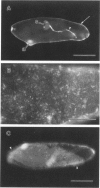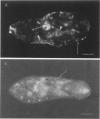Abstract
Low-density lipoproteins (LDL) may be important in human schistosomiasis because LDL bound to the surface of the parasite inhibits the binding of anti-schistosomal antibodies. Low-density lipoproteins also may serve as a source of lipids for the parasite membrane synthesis. Here LDL fluorescently labeled with carbocyanine dye (DiI-LDL) was used to measure the specificity of binding of LDL to the surface of schistosomula of Schistosoma mansoni and to examine the distribution of the LDL particles over time. DiI-LDL binding was saturable and specific, with strong inhibition by unlabeled LDL and apoB but not by apoA1, bovine serum albumin, or IgG, and only weak inhibition by high-density lipoproteins. Half of the bound DiI-LDL was displaced by unlabeled LDL. DiI-LDL remained bound on the surface of schistosomula for up to 36 hours in culture. However parasites also ingested both DiI-LDL and a second fluorescent LDL, Bodipy-LDL. Over time, both fluorophores appeared throughout the worm tissues, suggesting the LDL particles were breaking down and that the fluorophores and lipids originally contained within the LDL particle were partitioning throughout the worm. Thus human LDL appears to bind to the surface of schistosomula specifically. Ingested LDL appears to be broken down and may serve as a source of host lipids for the parasite.
Full text
PDF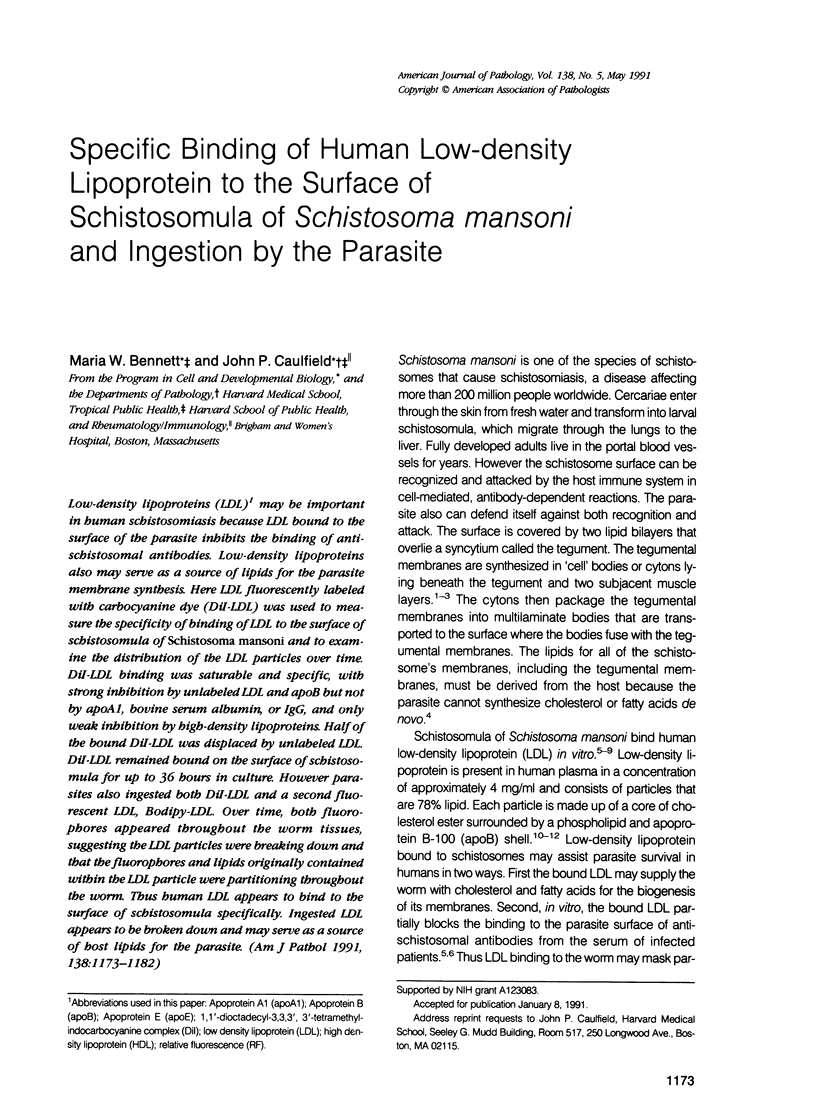
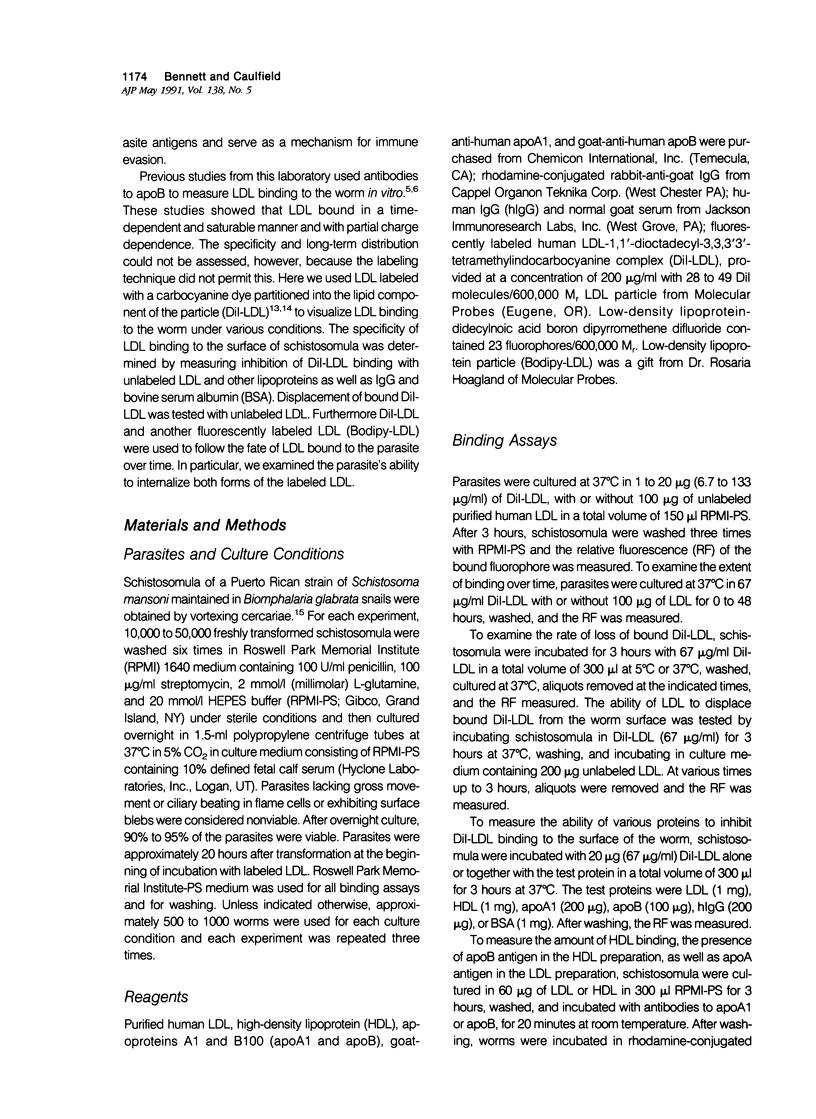
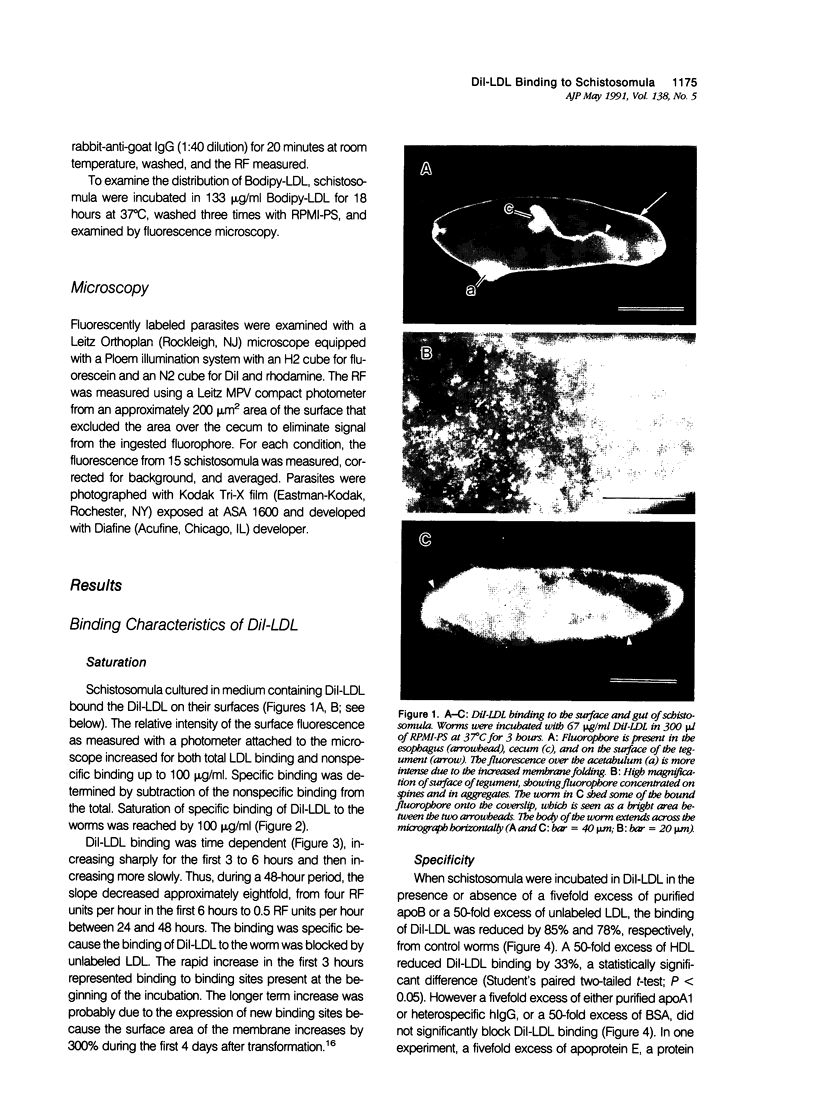
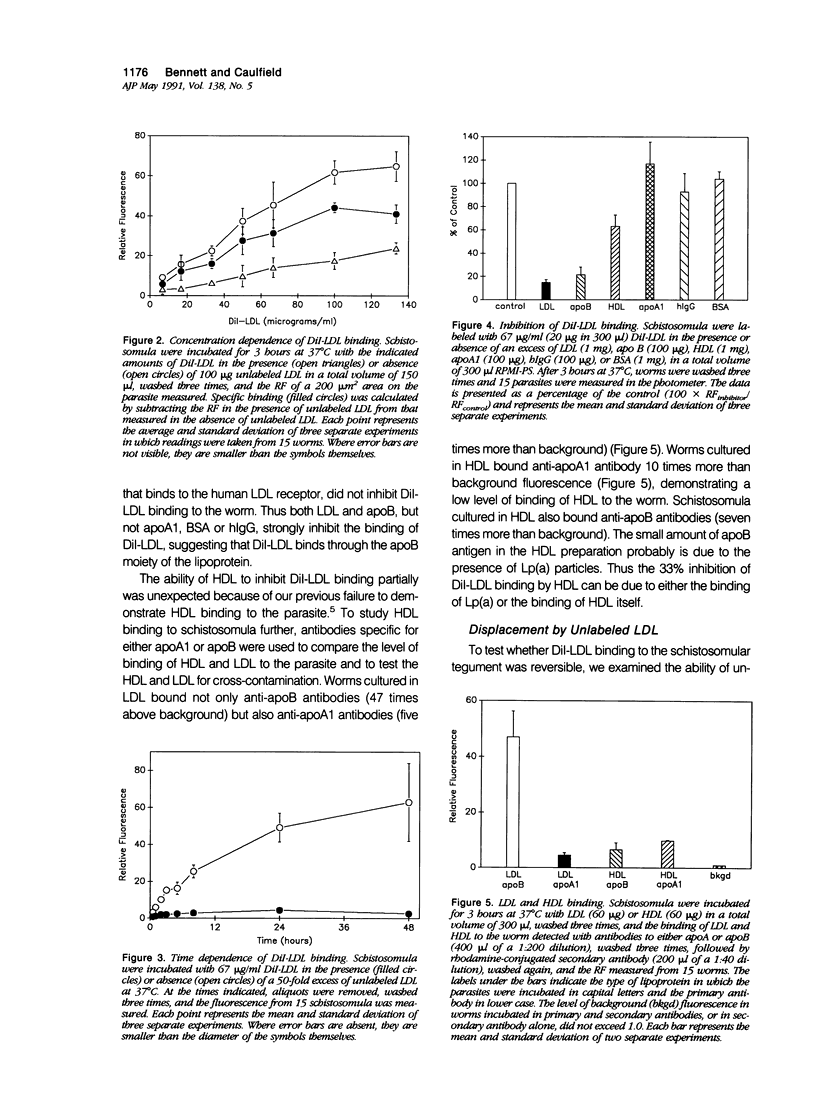
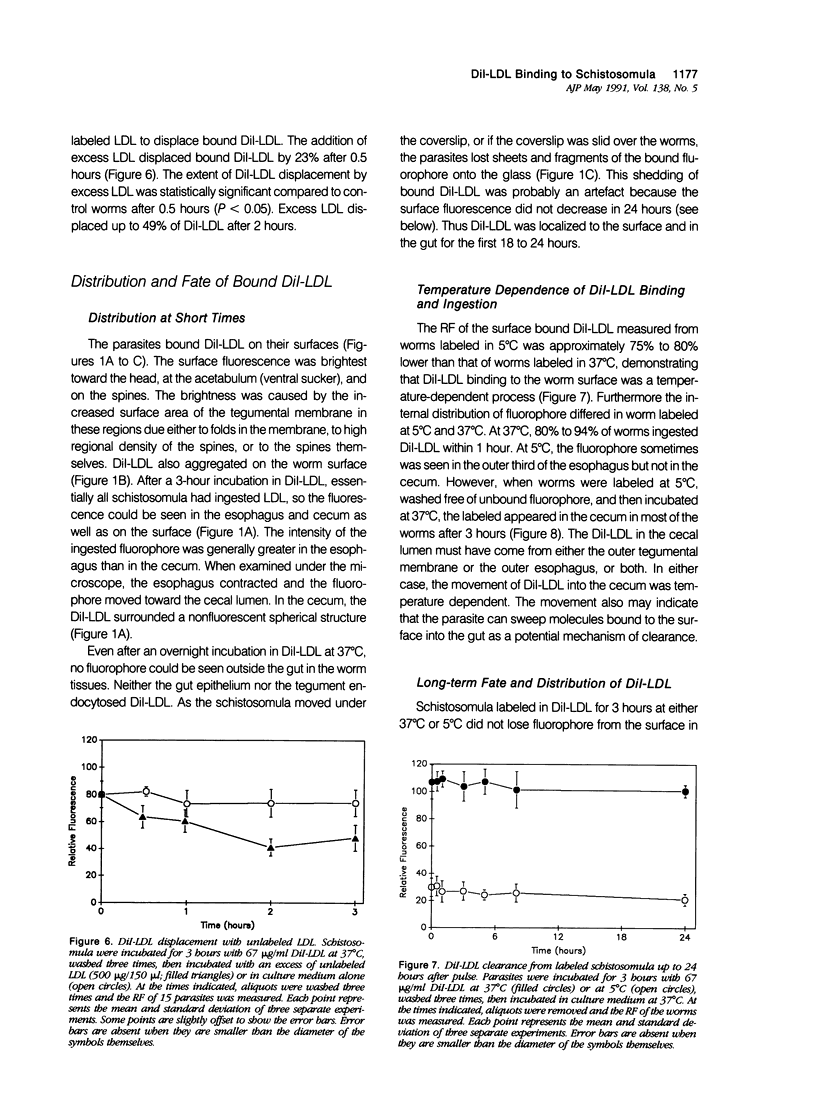
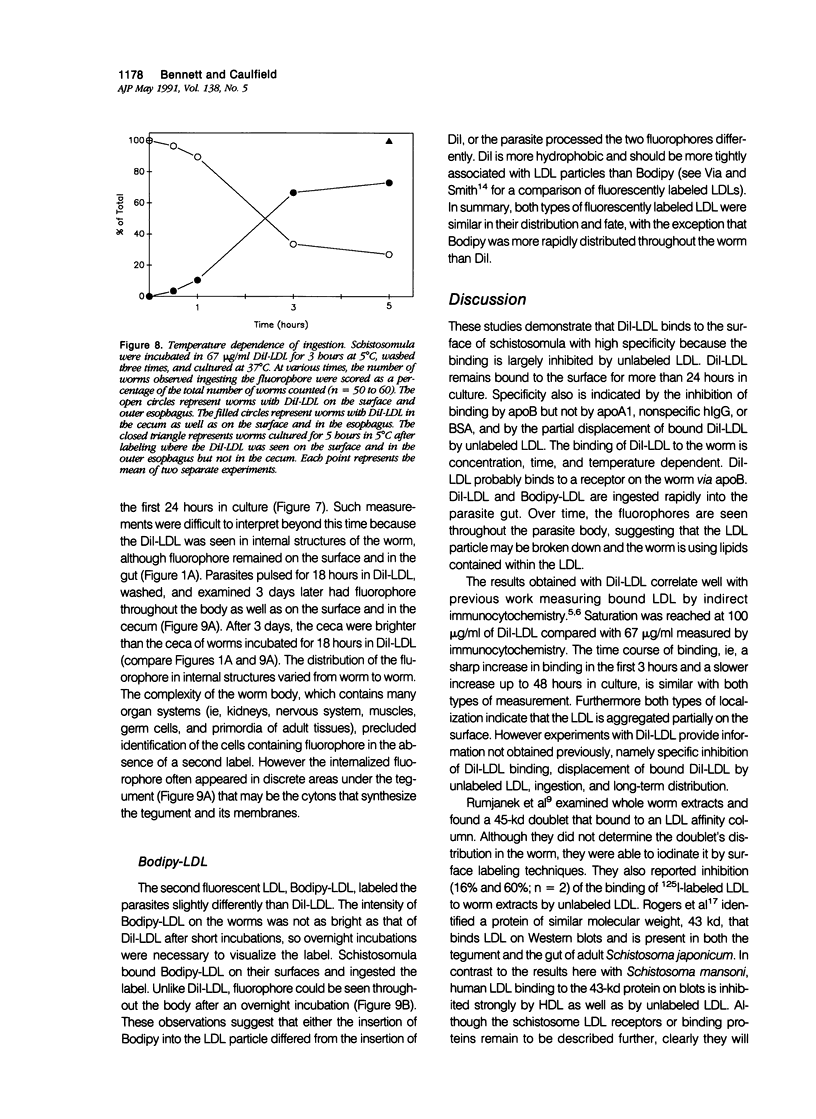
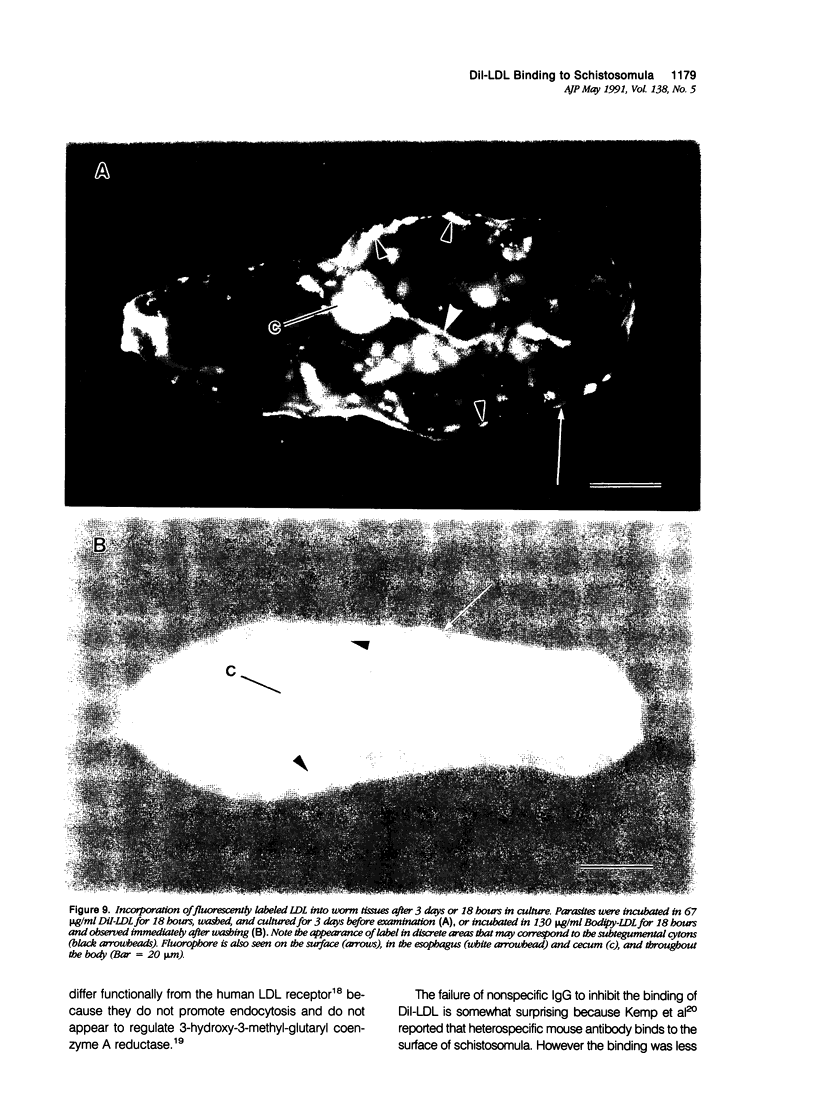
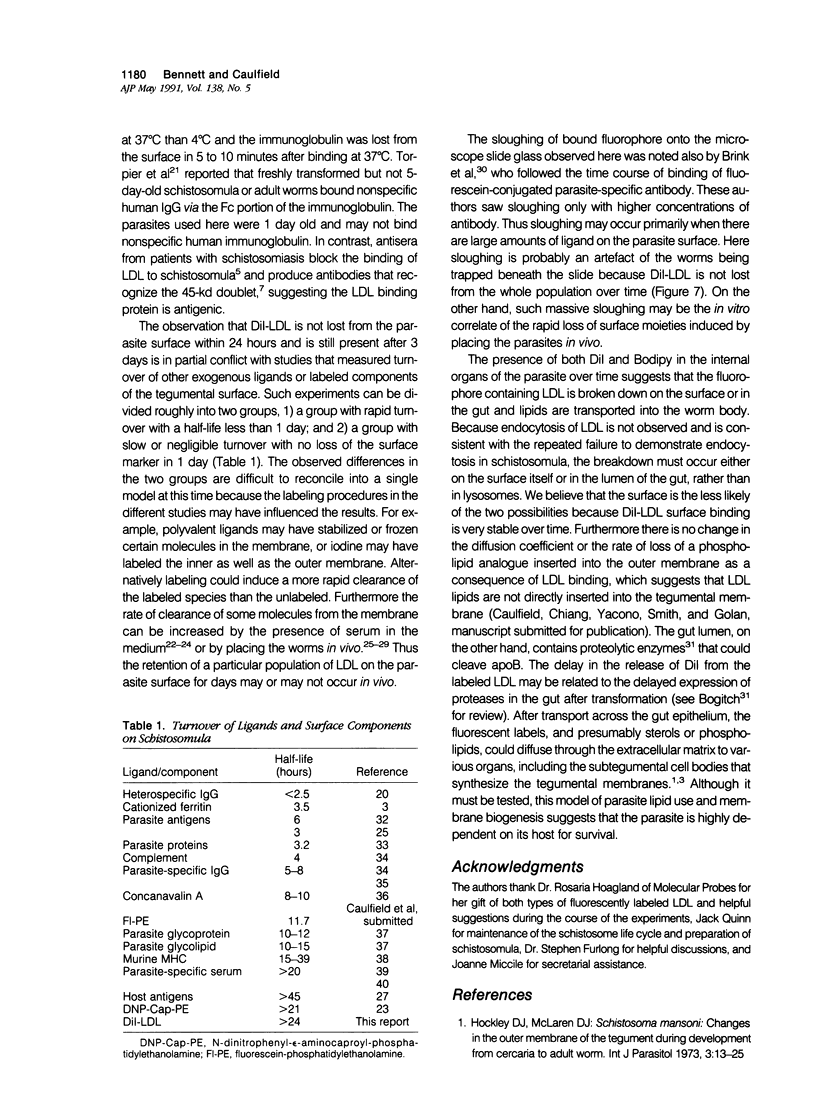
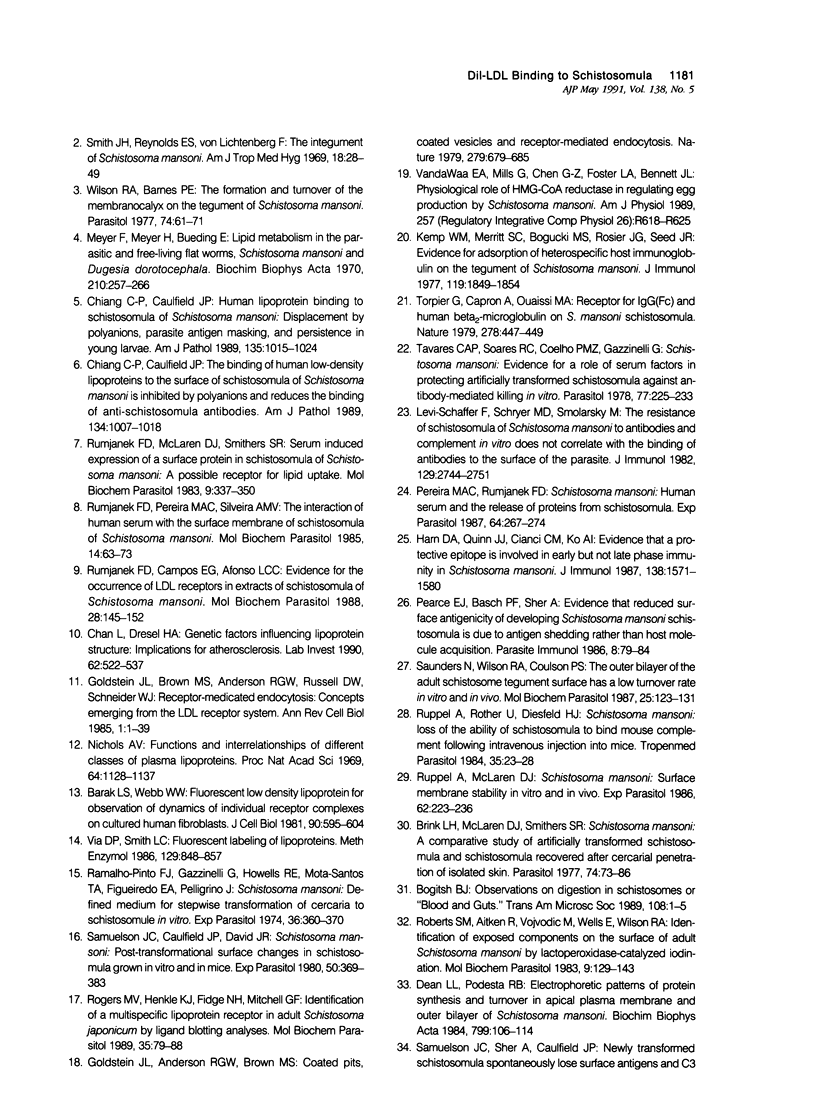
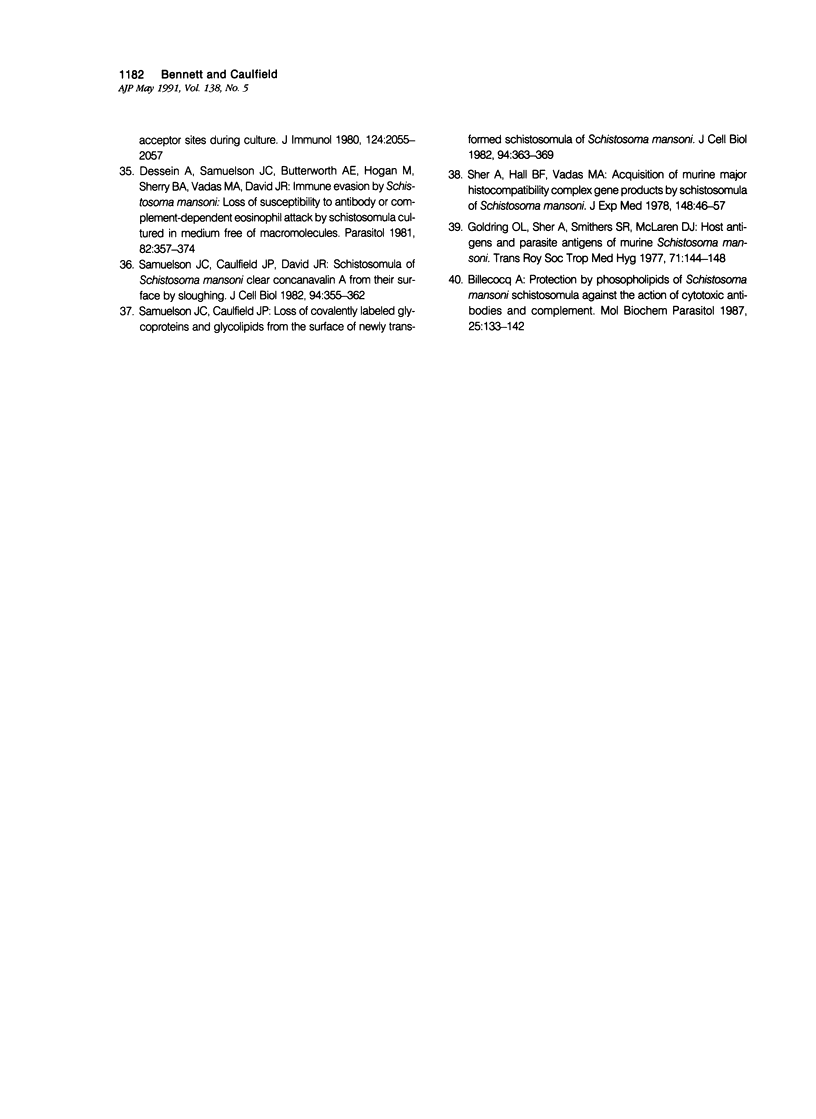
Images in this article
Selected References
These references are in PubMed. This may not be the complete list of references from this article.
- Barak L. S., Webb W. W. Fluorescent low density lipoprotein for observation of dynamics of individual receptor complexes on cultured human fibroblasts. J Cell Biol. 1981 Sep;90(3):595–604. doi: 10.1083/jcb.90.3.595. [DOI] [PMC free article] [PubMed] [Google Scholar]
- Billecocq A. Protection by phospholipids of Schistosoma mansoni schistosomula against the action of cytotoxic antibodies and complement. Mol Biochem Parasitol. 1987 Sep;25(2):133–142. doi: 10.1016/0166-6851(87)90002-8. [DOI] [PubMed] [Google Scholar]
- Brink L. H., McLaren D. J., Smithers S. R. Schistosoma mansoni: a comparative study of artificially transformed schistosomula and schistosomula recovered after cercarial penetration of isolated skin. Parasitology. 1977 Feb;74(1):73–86. doi: 10.1017/s0031182000047545. [DOI] [PubMed] [Google Scholar]
- Campana-Pereira M. A., Rumjanek F. D. Schistosoma mansoni: human serum and release of proteins from schistosomula. Exp Parasitol. 1987 Dec;64(3):267–274. doi: 10.1016/0014-4894(87)90036-1. [DOI] [PubMed] [Google Scholar]
- Chan L., Dresel H. A. Genetic factors influencing lipoprotein structure: implications for atherosclerosis. Lab Invest. 1990 May;62(5):522–537. [PubMed] [Google Scholar]
- Chiang C. P., Caulfield J. P. Human lipoprotein binding to schistosomula of schistosoma mansoni. Displacement by polyanions, parasite antigen masking, and persistence in young larvae. Am J Pathol. 1989 Dec;135(6):1015–1024. [PMC free article] [PubMed] [Google Scholar]
- Chiang C. P., Caulfield J. P. The binding of human low-density lipoproteins to the surface of schistosomula of Schistosoma mansoni is inhibited by polyanions and reduces the binding of anti-schistosomal antibodies. Am J Pathol. 1989 May;134(5):1007–1018. [PMC free article] [PubMed] [Google Scholar]
- Dean L. L., Podesta R. B. Electrophoretic patterns of protein synthesis and turnover in apical plasma membrane and outer bilayer of Schistosoma mansoni. Biochim Biophys Acta. 1984 Jun 15;799(2):106–114. doi: 10.1016/0304-4165(84)90283-6. [DOI] [PubMed] [Google Scholar]
- Dessein A., Samuelson J. C., Butterworth A. E., Hogan M., Sherry B. A., Vadas M. A., David J. R. Immune evasion by Schistosoma mansoni: loss of susceptibility to antibody or complement-dependent eosinophil attack by schistosomula cultured in medium free of macromolecules. Parasitology. 1981 Jun;82(Pt 3):357–374. doi: 10.1017/s0031182000066890. [DOI] [PubMed] [Google Scholar]
- Goldring O. L., Sher A., Smithers S. R., McLaren D. J. Host antigens and parasite antigens of murine Schistosoma mansoni. Trans R Soc Trop Med Hyg. 1977;71(2):144–148. doi: 10.1016/0035-9203(77)90083-9. [DOI] [PubMed] [Google Scholar]
- Goldstein J. L., Anderson R. G., Brown M. S. Coated pits, coated vesicles, and receptor-mediated endocytosis. Nature. 1979 Jun 21;279(5715):679–685. doi: 10.1038/279679a0. [DOI] [PubMed] [Google Scholar]
- Goldstein J. L., Brown M. S., Anderson R. G., Russell D. W., Schneider W. J. Receptor-mediated endocytosis: concepts emerging from the LDL receptor system. Annu Rev Cell Biol. 1985;1:1–39. doi: 10.1146/annurev.cb.01.110185.000245. [DOI] [PubMed] [Google Scholar]
- Harn D. A., Quinn J. J., Cianci C. M., Ko A. I. Evidence that a protective membrane epitope is involved in early but not late phase immunity in Schistosoma mansoni. J Immunol. 1987 Mar 1;138(5):1571–1580. [PubMed] [Google Scholar]
- Hockley D. J., McLaren D. J. Schistosoma mansoni: changes in the outer membrane of the tegument during development from cercaria to adult worm. Int J Parasitol. 1973 Jan;3(1):13–25. doi: 10.1016/0020-7519(73)90004-0. [DOI] [PubMed] [Google Scholar]
- Kemp W. M., Merritt S. C., Bogucki M. S., Rosier J. G., Seed J. R. Evidence for adsorption of heterospecific host immunoglobulin on the tegument of Schistosoma mansoni. J Immunol. 1977 Nov;119(5):1849–1854. [PubMed] [Google Scholar]
- Levi-Schaffer F., Schryer M. D., Somlarsky M. The resistance of schistosomula of Schistosoma mansoni to antibodies and complement in vitro does not correlate with the binding of antibodies to the surface of the parasite. J Immunol. 1982 Dec;129(6):2744–2751. [PubMed] [Google Scholar]
- Meyer F., Meyer H., Bueding E. Lipid metabolism in the parasitic and free-living flatworms, Schistosoma mansoni and Dugesia dorotocephala. Biochim Biophys Acta. 1970 Jul 14;210(2):257–266. doi: 10.1016/0005-2760(70)90170-0. [DOI] [PubMed] [Google Scholar]
- Nichols A. V. Functions and interrelationships of different classes of plasma lipoproteins. Proc Natl Acad Sci U S A. 1969 Nov;64(3):1128–1137. doi: 10.1073/pnas.64.3.1128. [DOI] [PMC free article] [PubMed] [Google Scholar]
- Pearce E. J., Basch P. F., Sher A. Evidence that the reduced surface antigenicity of developing Schistosoma mansoni schistosomula is due to antigen shedding rather than host molecule acquisition. Parasite Immunol. 1986 Jan;8(1):79–94. doi: 10.1111/j.1365-3024.1986.tb00835.x. [DOI] [PubMed] [Google Scholar]
- Ramalho-Pinto F. J., Gazzinelli G., Howells R. E., Mota-Santos T. A., Figueiredo E. A., Pellegrino J. Schistosoma mansoni: defined system for stepwise transformation of cercaria to schistosomule in vitro. Exp Parasitol. 1974 Dec;36(3):360–372. doi: 10.1016/0014-4894(74)90076-9. [DOI] [PubMed] [Google Scholar]
- Roberts S. M., Aitken R., Vojvodic M., Wells E., Wilson R. A. Identification of exposed components on the surface of adult Schistosoma mansoni by lactoperoxidase-catalysed iodination. Mol Biochem Parasitol. 1983 Oct;9(2):129–143. doi: 10.1016/0166-6851(83)90105-6. [DOI] [PubMed] [Google Scholar]
- Rogers M. V., Henkle K. J., Fidge N. H., Mitchell G. F. Identification of a multispecific lipoprotein receptor in adult Schistosoma japonicum by ligand blotting analyses. Mol Biochem Parasitol. 1989 Jun 1;35(1):79–88. doi: 10.1016/0166-6851(89)90145-x. [DOI] [PubMed] [Google Scholar]
- Rumjanek F. D., Campos E. G., Afonso L. C. Evidence for the occurrence of LDL receptors in extracts of schistosomula of Schistosoma mansoni. Mol Biochem Parasitol. 1988 Mar;28(2):145–152. doi: 10.1016/0166-6851(88)90062-x. [DOI] [PubMed] [Google Scholar]
- Rumjanek F. D., McLaren D. J., Smithers S. R. Serum-induced expression of a surface protein in schistosomula of Schistosoma mansoni: a possible receptor for lipid uptake. Mol Biochem Parasitol. 1983 Dec;9(4):337–350. doi: 10.1016/0166-6851(83)90090-7. [DOI] [PubMed] [Google Scholar]
- Rumjanek F. D., Pereira M. A., Silveira A. M. The interaction of human serum with the surface membrane of schistosomula of Schistosoma mansoni. Mol Biochem Parasitol. 1985 Jan;14(1):63–73. doi: 10.1016/0166-6851(85)90106-9. [DOI] [PubMed] [Google Scholar]
- Ruppel A., McLaren D. J. Schistosoma mansoni: surface membrane stability in vitro and in vivo. Exp Parasitol. 1986 Oct;62(2):223–236. doi: 10.1016/0014-4894(86)90027-5. [DOI] [PubMed] [Google Scholar]
- Ruppel A., Rother U., Diesfeld H. J. Schistosoma mansoni: loss of the ability of schistosomula to bind mouse complement following intravenous injection into mice. Tropenmed Parasitol. 1984 Mar;35(1):23–28. [PubMed] [Google Scholar]
- Samuelson J. C., Caulfield J. P., David J. R. Schistosoma mansoni: post-transformational surface changes in schistosomula grown in vitro and in mice. Exp Parasitol. 1980 Dec;50(3):369–383. doi: 10.1016/0014-4894(80)90040-5. [DOI] [PubMed] [Google Scholar]
- Samuelson J. C., Caulfield J. P., David J. R. Schistosomula of Schistosoma mansoni clear concanavalin A from their surface by sloughing. J Cell Biol. 1982 Aug;94(2):355–362. doi: 10.1083/jcb.94.2.355. [DOI] [PMC free article] [PubMed] [Google Scholar]
- Samuelson J. C., Caulfield J. P. Loss of covalently labeled glycoproteins and glycolipids from the surface of newly transformed schistosomula of Schistosoma mansoni. J Cell Biol. 1982 Aug;94(2):363–369. doi: 10.1083/jcb.94.2.363. [DOI] [PMC free article] [PubMed] [Google Scholar]
- Saunders N., Wilson R. A., Coulson P. S. The outer bilayer of the adult schistosome tegument surface has a low turnover rate in vitro and in vivo. Mol Biochem Parasitol. 1987 Sep;25(2):123–131. doi: 10.1016/0166-6851(87)90001-6. [DOI] [PubMed] [Google Scholar]
- Sher A., Hall B. F., Vadas M. A. Acquisition of murine major histocompatibility complex gene products by schistosomula of Schistosoma mansoni. J Exp Med. 1978 Jul 1;148(1):46–57. doi: 10.1084/jem.148.1.46. [DOI] [PMC free article] [PubMed] [Google Scholar]
- Smith J. H., Reynolds E. S., Von Lichtenberg F. The integument of Schistosoma mansoni. Am J Trop Med Hyg. 1969 Jan;18(1):28–49. [PubMed] [Google Scholar]
- Tavares C. A., Soares R. C., Coelho P. M., Gazzinelli G. Schistosoma mansoni: evidence for a role of serum factors in protecting artificially transformed schistosomula against antibody-mediated killing in vitro. Parasitology. 1978 Oct;77(2):225–243. doi: 10.1017/s0031182000049404. [DOI] [PubMed] [Google Scholar]
- Torpier G., Capron A., Ouaissi M. A. Receptor for IgG(Fc) and human beta2-microglobulin on S. mansoni schistosomula. Nature. 1979 Mar 29;278(5703):447–449. doi: 10.1038/278447a0. [DOI] [PubMed] [Google Scholar]
- Vandewaa E. A., Mills G., Chen G. Z., Foster L. A., Bennett J. L. Physiological role of HMG-CoA reductase in regulating egg production by Schistosoma mansoni. Am J Physiol. 1989 Sep;257(3 Pt 2):R618–R625. doi: 10.1152/ajpregu.1989.257.3.R618. [DOI] [PubMed] [Google Scholar]
- Via D. P., Smith L. C. Fluorescent labeling of lipoproteins. Methods Enzymol. 1986;129:848–857. doi: 10.1016/0076-6879(86)29108-9. [DOI] [PubMed] [Google Scholar]
- Wilson R. A., Barnes P. E. The formation and turnover of the membranocalyx on the tegument of Schistosoma mansoni. Parasitology. 1977 Feb;74(1):61–71. doi: 10.1017/s0031182000047533. [DOI] [PubMed] [Google Scholar]



